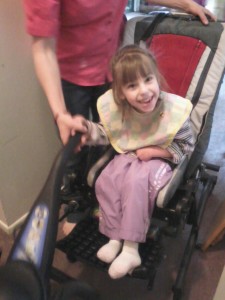One of the chapters in my upcoming book is about the stories we tell ourselves and how those stories affect our relationships with our kids.
You’ve all heard this old saying or something like it, “What you say is what you get.” It’s true.
 If you say “My kids are driving me nuts,” they’ll drive you nuts. If you say “I can’t stand my kids today,” or “My kids are so sloppy, messy, noisy, naughty, etc.,” that’s what you’ll get. It’s what you perceive is happening, regardless of what’s actually going on. This will influence your response and your ability to be Present.
If you say “My kids are driving me nuts,” they’ll drive you nuts. If you say “I can’t stand my kids today,” or “My kids are so sloppy, messy, noisy, naughty, etc.,” that’s what you’ll get. It’s what you perceive is happening, regardless of what’s actually going on. This will influence your response and your ability to be Present.
The negative stories you tell yourself over and over again impact how you feel about your children and your ability to be Present with them. Negative thoughts hinder you from achieving things you want. Positive thoughts do the opposite.
Saying, “My kids are so messy,” or “My son doesn’t respect me,” generates low energy. This low energy attracts the very thing which is distressing us. If our words are, “I love being with my kids,” “My daughter is sure helpful today,” or “I’m having a peaceful day,” we generate high energy which attracts what we want to have happen.
Think of all the phrases we say and hear over and over again about kids:
• You’re driving me crazy.
• You’re so messy.
• You’re so noisy.
• I can’t get a minute’s peace.
• Why can’t you listen to me? You never listen!
• You’re so irresponsible.
• I don’t know what I’m going to do with you!
• You make me so mad.
• You’re so sloppy, disobedient, messy, argumentative, quarrelsome, etc.
• You’re wearing me out.
• I can’t listen one more minute.
 If we want better outcomes, we need to watch our words. Say what you want, not what you don’t want. Words are your thoughts/stories put into concrete form. Words generate emotions. You’ll feel the way you speak. How you feel moves you to an action which gives you a result, either good or bad. Your words move you closer to or away from the ability to be Present.
If we want better outcomes, we need to watch our words. Say what you want, not what you don’t want. Words are your thoughts/stories put into concrete form. Words generate emotions. You’ll feel the way you speak. How you feel moves you to an action which gives you a result, either good or bad. Your words move you closer to or away from the ability to be Present.
Take responsibility for your thoughts, the stories and emotions they create, and your responses. Stop blaming. Take responsibility for your words, which are your stories in concrete form.
You’re in control of the stories you tell; stories about yourself, your family, your children and the world, the past, the present and the future. Knowing this gives you ALL the power.
REMEMBER the summer Zing I mentioned was coming? Well, it’s here. On June 30th at 7pm MST I will be hosting a webinar for mom’s and dad’s who want to be PRESENT this summer in fun and easy ways. Ways that occur every day all ready. No pre-planning. No extra time or fuss. Check it out here. I hope you’ll join me.
Happy Summer,
Mary Ann
Possibly Related Posts:
- Shedding My Skin
- Touchpoints For Summer PRESENCE
- Top 10 Educational Apps for Kids
- Family Matters: 4 Pool Games for Having Fun as a Family – Guest Post
- Make it Special – Chores and Family Work
{ 0 comments }




